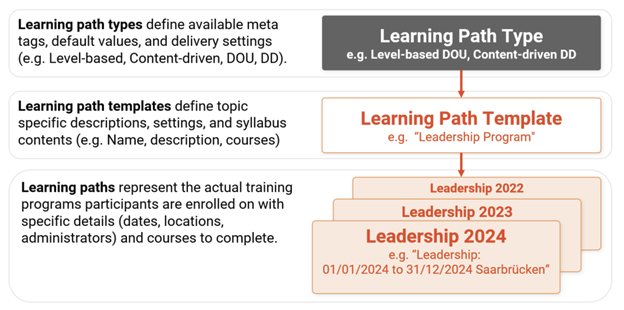Learning Paths
Learning paths illustrate long-term training plans that run over several courses. These can consist of a mixture of online courses, blended learning courses, and classroom training. For a better organisation, it is possible to create folders in the learning path manager, which describe different phases of the learning path. Dependencies can also be created between the individual courses, like the learning logic in courses. Prerequisites can also be assigned. By using learning logic rules, you can map open learning concepts with a freely selectable processing sequence as well as closed scenarios in which the sequence is defined step-by-step.
Two learning path modes are available: content-oriented and level-based.
A content-oriented learning path is used to provide and track structured content over a longer period, e.g., for a 6-month onboarding program where a series of courses must be completed.
In a level-based learning path, a sequence of levels can also be defined (e.g., beginner, advanced, expert), which a user can reach if he successfully completes all courses of the corresponding level. The defined levels can be linked to conditions and access restrictions.
If a learning path is completed by the learner or set by the administrator the personal end date of the learning path is set to this point in time. A personal start date cannot be set, because a learning path does not have the status “started” of “in progress“. For learning paths after the status “enrolled” directly follows the status “completed“.
Learners can obtain, if configured, certificates either on the overall learning path and, for level-based learning paths also on everyone achieved level. Learners can, for example, book learning paths themselves via the catalogue. The information available for a learning path on the detail page can be configured using imc Learning Suite. A preview image also motivates participation in learning paths.
Supervisors also have the option of booking learners directly to courses within a learning path.
Like courses, learning paths also support automatic booking. Via participant management, learning path creators can define groups and job profiles for which they then define conditions for automatic booking.
In addition, it is also possible to define that courses contained in the path are also automatically booked for the learner when they are booked on the learning path.
Learning paths can also be used in the recertification process. Accurate recertification periods can be specified, with the ability to add different recertification content for each period. The learning path administrator will find separate settings for this in the backend.
If the learning path needs to be canceled, the cancellation applied on learning path level can be automatically applied to the courses contained in the learning path.
If multiple languages are available a language switch of the learning path is possible also for the learner. When the language of the learning path is changed, all contained courses will also be set to the new language.

Sturucture of Learning paths
The image above shows the Learning Path framework object relationship and creation process. A Learning Path is created from a Learning Path Template that predefines most settings, general description information and syllabus content; therefore, the first step prior to creating a Learning Path is to check if a related Learning Path Template has already been created. If not, then creating a Learning Path Template from a suitable Learning Path Type will be required. The Learning Path Type is basically a master template used to predefine the available meta tag fields and default settings, and available tabs to populate when creating a Course Template.
Note: The "Learning path type" function is not available in the "Content" category as it's rare to create new or re-configure Learning Path Types as they are intended as master templates to control settings. Learning Path Types are normally managed by System Administrators.
